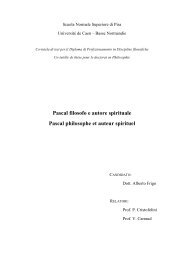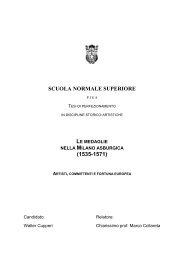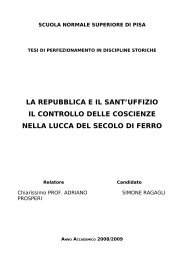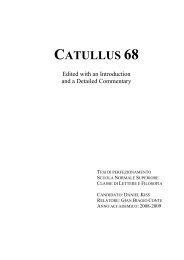- Page 1: Tesi di Perfezionamento Scuola Norm
- Page 4 and 5: iflessioni si sono rivelate un vali
- Page 7 and 8: Introduzione Obiettivo di questa pr
- Page 9 and 10: La Téchnē si presenta come un man
- Page 11 and 12: sul rapporto tra Tempi e Modi sono
- Page 13 and 14: che si erano sviluppate all’inter
- Page 15 and 16: In entrambi i passi, la nozione del
- Page 17: procederà, quindi, all’esame deg
- Page 21 and 22: “Il verbo è una parte della fras
- Page 23 and 24: Nello scolio di Eliodoro la definiz
- Page 25 and 26: suntakto;n peri; tino;~ h] tinw'n,
- Page 27 and 28: Nella prima parte della definizione
- Page 29 and 30: considerazioni riguardo ai nomi e a
- Page 31 and 32: fronouvmeno~, per questo è chiamat
- Page 33 and 34: 2.1 La definizione dei Tempi Capito
- Page 35 and 36: Téchnē (cap. 19), gli avverbi “
- Page 37 and 38: stesso usato da Aristotele nella Po
- Page 39 and 40: Per cui, se gli ottativi e gli impe
- Page 41 and 42: e[grafon h] to; ejgegravfein h] ajp
- Page 43 and 44: paravtasin dhlou'nta tou' panto;~ c
- Page 45 and 46: - anche per quanto riguarda i Tempi
- Page 47 and 48: Tornando al passo degli Avverbi, Ap
- Page 49 and 50: Le descrizioni del PR e del FU sono
- Page 51 and 52: (sunetelevsqhsan) e sono azioni pre
- Page 53 and 54: crovnou ejmfaivnei, wJ~ oiJ uJpokei
- Page 55 and 56: del Perfetto e nella terza un tema
- Page 57 and 58: fatto che l’azione espressa dall
- Page 59 and 60: “completo” (tevleio") e può
- Page 61 and 62: mevllonto~ wJ~ mevllonto~ oujde;n t
- Page 63 and 64: Riguardo all’indefinitezza di AO
- Page 65 and 66: finem eius non peruenerim et cum pa
- Page 67: Anche Prisciano divide il tempo in
- Page 70 and 71:
stato compreso dai grammatici stess
- Page 72 and 73:
casi, cioè, non si può dire esatt
- Page 74 and 75:
parlando dell’Indicativo, ma non
- Page 76 and 77:
3.2.2 I Tempi compiuti Ci occuperem
- Page 78 and 79:
dhlw'n kairo;n wJrismevnon mhde; pa
- Page 80 and 81:
sempre e senza interruzione “non
- Page 82 and 83:
mediante il TLG, tutte le attestazi
- Page 84 and 85:
oujk ou\sin aiJ eujcai; givnontai e
- Page 86 and 87:
sottolineare la differenza con il P
- Page 88 and 89:
degente, optans dicam |utinam Romae
- Page 90 and 91:
crovnou). Per Lallot (1997 II: 216)
- Page 92 and 93:
questo ejpimevnoi~ zw'n [Ott. PR +
- Page 94 and 95:
[Imp. PR ‘si chiuda la porta’]
- Page 96 and 97:
pas par ‘j’ordonne que l’acti
- Page 98 and 99:
post horam primam |finitam sit iura
- Page 100 and 101:
ei[ge ta; ginovmena kai; gegonovta
- Page 102 and 103:
non sono noti, mentre quelli ginovm
- Page 104 and 105:
ajnagnw': tevlei ga;r ejcrhvsato ta
- Page 106 and 107:
indicata da Apollonio, consiste nel
- Page 108 and 109:
Nei paragrafi 141 e 143, Apollonio
- Page 110 and 111:
sostenuto che i{na causale era in r
- Page 112 and 113:
wjfelhvqhnÃÃ kai; ããdiovti e[pr
- Page 114 and 115:
tuvptwn [Cong. AO + Part. ‘non co
- Page 116 and 117:
parelhluqovtwn, shmasivan de; mevll
- Page 118 and 119:
numeri e le persone, di cui l’inf
- Page 120 and 121:
ª...º oJmovlogon de; kajkei'nov e
- Page 122 and 123:
somiglia a quelle in cui il Pf e il
- Page 124 and 125:
nelle descrizioni dell’Indicativo
- Page 126 and 127:
(2000a: 295). Tale visione viene co
- Page 128 and 129:
altri Modi, e ciò ha dato luogo a
- Page 130 and 131:
130
- Page 132 and 133:
frequenza di imperativi risulta mag
- Page 134 and 135:
che saranno poi definite con l’op
- Page 136 and 137:
Humbert (1945), riferendosi al PR,
- Page 138 and 139:
volta la scelta aspettuale. Duhoux
- Page 140 and 141:
ad una modificazione del significat
- Page 142 and 143:
l’accomplissement pur et simple (
- Page 144 and 145:
1.2 Il “Gruppo di ricerca sull’
- Page 146 and 147:
encore inachevée, tandis que le TA
- Page 148 and 149:
Perfetto, trattato nel libro del 19
- Page 150 and 151:
Si ritiene necessario richiamare in
- Page 152 and 153:
fondamentali che permettono di sudd
- Page 154 and 155:
(2000). 331 Questi studi costituisc
- Page 156 and 157:
apporto tra i Tempi e le proprietà
- Page 158 and 159:
- se i verbi che hanno un paradigma
- Page 160 and 161:
dei risultati, derivanti dall’ana
- Page 162 and 163:
un campo apposito, la sua presenza/
- Page 164 and 165:
Rane Tesmoforiazuse Simposio Sulla
- Page 166 and 167:
Ou|to~, tiv kuvptei~… Dh'son aujt
- Page 168 and 169:
perfettivo. Questo vale sia nel cas
- Page 170 and 171:
dei PR (342) c’è una maggiore pr
- Page 172 and 173:
ejk- 11 volte solo con forme telich
- Page 174 and 175:
all’AO e 3 al PR 381 , poievw (8
- Page 176 and 177:
appresenta una deviazione di 10 pun
- Page 178 and 179:
All’interno del campione in alcun
- Page 180 and 181:
nella banca-dati come incerto. Cons
- Page 182 and 183:
Euripide ed Eschilo, devono rispond
- Page 184 and 185:
considerazioni esposte fin qui, il
- Page 186 and 187:
verbo oi\da, ha valore di PR. Le fo
- Page 188 and 189:
188
- Page 190 and 191:
Con l’imperativo AO viene chiesto
- Page 192 and 193:
DI. Majlla; plei'n h] maivnomai. HR
- Page 194 and 195:
“Agatone, vedi se puoi venirmi in
- Page 196 and 197:
capire quale dei due sia un dio. L
- Page 198 and 199:
In (28) l’arciere invita la ragaz
- Page 200 and 201:
(31b) Oujk a]n fqavnoimi, eijpei'n
- Page 202 and 203:
4.2 I valori azionali degli imperat
- Page 204 and 205:
(39b) DI. Peiqw; de; kou'fovn ejsti
- Page 206 and 207:
Il verbo eu[comai ricorre 5 volte a
- Page 208 and 209:
“Ma che io non abbia fatto tutte
- Page 210 and 211:
Nell’esempio, i due imperativi PR
- Page 212 and 213:
(55b) ei\ta levgei~ wJ~ oujde;n o{m
- Page 214 and 215:
Questa forma al presente di lambavn
- Page 216 and 217:
“[...] state bene.” (Dem. 18, 7
- Page 218 and 219:
“Poiché questi parla con superbi
- Page 220 and 221:
ejpainei'n. eja;n ou\n
uJpo; soi
- Page 222 and 223:
(69) Basileu;" Makedovnwn Fivlippo"
- Page 224 and 225:
maggioritaria da verbi con valore t
- Page 226 and 227:
l’unica in grado di spiegare in m
- Page 228 and 229:
228
- Page 230 and 231:
ajnamevnw ajnavmeinon AO Rane 175 a
- Page 232 and 233:
deivknumi dei'xon AO Sulla corona 1
- Page 234 and 235:
ei\pon eijpev AO Simposio 173a3 ei\
- Page 236 and 237:
e[ [cw e[ce PR Tesmoforiazuse 236 e
- Page 238 and 239:
lambavnw lavbe AO Storie 108 levgw
- Page 240 and 241:
mimnhvskw mevmnhso Pf Rane 1520 mis
- Page 242 and 243:
poievw poivhson AO Storie 112 poiev
- Page 244 and 245:
toreuvw tovreue PR Tesmoforiazuse 9
- Page 246 and 247:
246
- Page 248 and 249:
Techne grammatike. Dionisio Trace,
- Page 250 and 251:
AGRÉLL, Sigurd, 1908, Aspektänder
- Page 252 and 253:
BERRETTONI, Pierangiolo, 1996, “L
- Page 254 and 255:
CROFT, W., 1998, “The structure o
- Page 256 and 257:
FRIEDRICH, Paul, 1974, “On Aspect
- Page 258 and 259:
KÜHNER, Raphael e Bernhard GERTH,
- Page 260 and 261:
LYONS, John, 1977, Semantics, Cambr
- Page 262 and 263:
RAMAT, Anna Giacalone e Paolo RAMAT
- Page 264 and 265:
THIEROFF, Rolf, 1994, “Inherent c
- Page 266 and 267:
266
- Page 268 and 269:
4.2 L’Ottativo 83 4.3 L’Imperat






